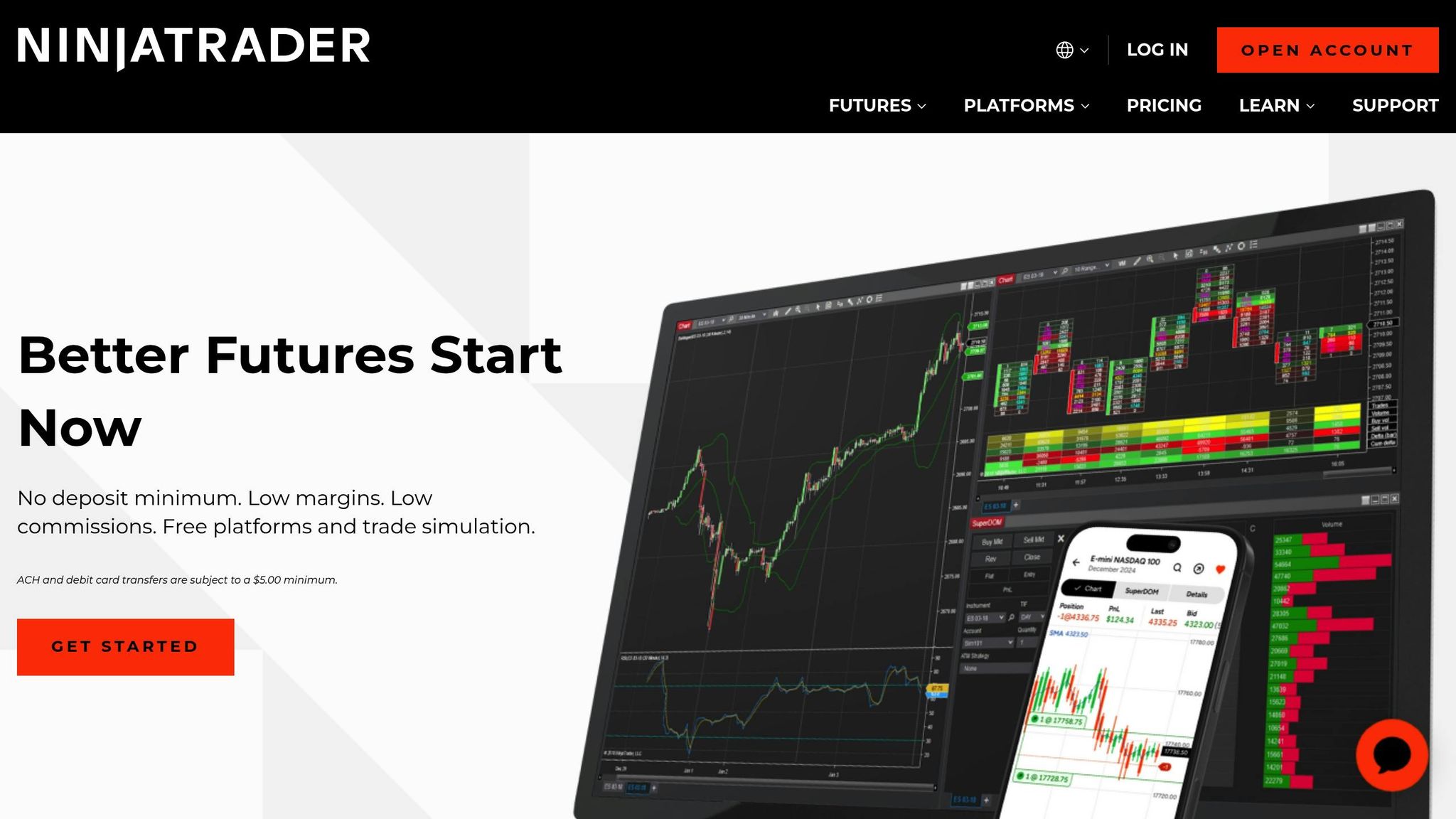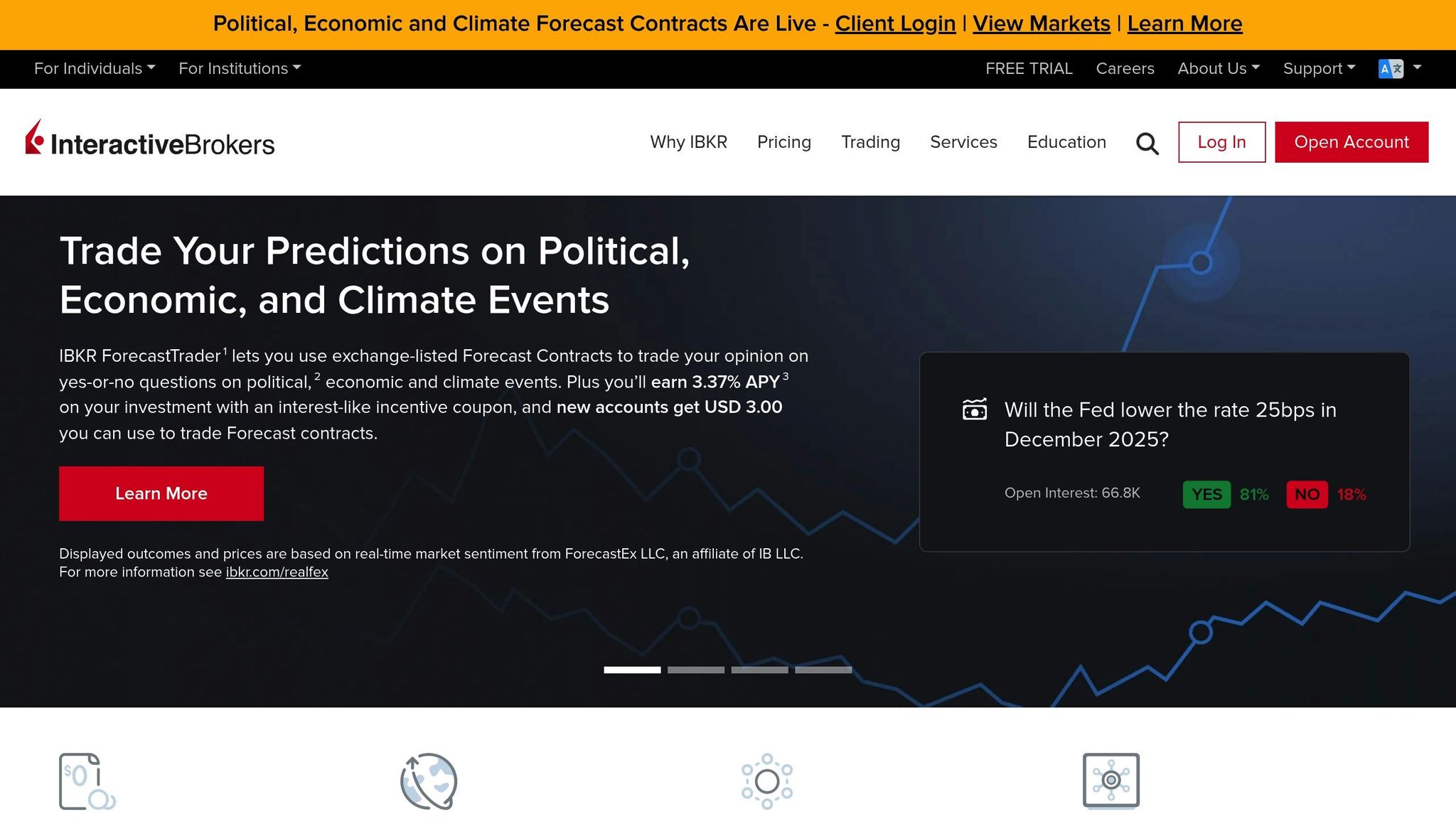When trading futures, keeping costs low is critical for maximizing profits. This article reviews five online platforms – NinjaTrader, Tradovate, Interactive Brokers, Webull, and AMP Futures – focusing on their fees, margin requirements, and usability. Here’s a quick breakdown:
- NinjaTrader: Offers tiered pricing with competitive commission rates. Best for high-volume traders or those using automated strategies.
- Tradovate: Subscription-based pricing for predictable costs. Ideal for active traders who prioritize simplicity.
- Interactive Brokers: Advanced tools and precise execution. Suited for professional traders with larger portfolios.
- Webull: Mobile-friendly with no account minimums. Accessible for beginners but limited in futures options.
- AMP Futures: Low commissions and flexible third-party integrations. Great for cost-conscious traders.
Each platform caters to specific trading styles and needs. Below is a comparison table for quick insights.
Quick Comparison
| Platform | Commission Rates | Margin Requirements | Key Features | Best For |
|---|---|---|---|---|
| NinjaTrader | $0.09–$1.29 per side | $50+ | Advanced tools, automation options | High-volume, automated traders |
| Tradovate | Subscription-based ($0+) | Varies | Web-based, mobile-friendly | Active traders seeking predictability |
| Interactive Brokers | $0.25–$1.50 per contract | $50+ | Institutional-grade tools | Professionals, large portfolios |
| Webull | $0.25–$1.50 per contract | Low | Mobile-first, no account minimums | Beginners, budget-conscious traders |
| AMP Futures | $0.25 per contract | Low | Low-cost, third-party integrations | Cost-conscious traders |
Choose the platform that aligns with your trading volume, style, and goals.
Best Futures Trading Platforms | My Top 3 For Day Traders
1. NinjaTrader

NinjaTrader stands out as a cost-effective choice for futures traders, thanks to its flexible pricing structure. With three distinct pricing plans, it caters to a variety of trading volumes and budgets, allowing users to pick an option that suits their trading style and financial goals.
Commission Rates
NinjaTrader offers three pricing tiers:
- Free Plan: Standard rates with no monthly platform fees. Traders pay $0.35 per side for micro futures contracts and $1.29 for standard contracts.
- Monthly Plan: Costs $99 per month and reduces rates to $0.25 for micro contracts and $0.99 for standard contracts.
- Lifetime Plan: Designed for high-volume traders, this plan requires a one-time payment of $1,499 and offers the lowest rates – $0.09 per side for micro futures and $0.59 for standard contracts.
These competitive rates, especially under the Lifetime Plan, make NinjaTrader an attractive option for active traders. Combined with low margin requirements, the platform ensures cost efficiency for those trading frequently.
Margin Requirements
NinjaTrader requires a minimum margin of just $50 to start trading, making it accessible for traders with smaller accounts. Its intraday margin requirements are particularly favorable for micro futures, allowing active day traders to manage their capital more efficiently.
Since futures trading is regulated by the CFTC rather than FINRA, the Pattern Day Trader (PDT) rule doesn’t apply. This allows traders to operate with lower capital compared to equity markets. However, during major economic events, NinjaTrader may temporarily raise margin requirements to mitigate risk – a standard practice in the industry.
Data and Platform Fees
The basic NinjaTrader platform is free and includes simulated trading features, making it easy for users to explore the system without upfront costs. However, live futures trading requires separate market data subscriptions, which add to the overall cost.
For traders seeking lower commissions, the Monthly and Lifetime Plans provide significant savings over time. These tiered options are especially beneficial for those trading at higher volumes.
Suitability for Traders
NinjaTrader has been recognized by Investopedia as the "Best for Dedicated Futures Traders" and holds a 4.3/5 rating from NerdWallet. Its appeal lies in its strong charting tools, 24-hour customer support, and integration across desktop, web, and mobile platforms.
The Lifetime Plan is ideal for traders who execute enough volume to justify the upfront cost, offering long-term savings. The Monthly Plan, on the other hand, provides reduced rates without requiring a large initial investment.
That said, NinjaTrader is tailored exclusively for futures trading. It doesn’t support direct equity or options trading, which may limit its appeal for those looking to diversify into these markets. Additionally, beginners might find the interface somewhat challenging to navigate, requiring a time investment to fully grasp its features.
For traders running automated strategies, NinjaTrader’s platform works seamlessly with VPS hosting solutions, ensuring reliable 24/7 uptime and smooth performance for algorithmic trading systems.
2. Tradovate

Tradovate takes a modern spin on futures trading, standing out as a web-based platform with a subscription model that simplifies fee management for traders.
Pricing and Fees
Instead of traditional per-trade commissions, Tradovate offers a fixed monthly subscription. This setup provides active traders with consistent and predictable costs, which can be a big plus for those making frequent trades.
Margin and Trading Requirements
Tradovate’s margin requirements align with standard industry practices. For the most accurate and up-to-date details, it’s best to check directly with the platform.
Platform Features
Tradovate is designed with simplicity and accessibility in mind. Its web-based platform delivers real-time market data and works seamlessly across mobile devices, making it easy for traders on the move. The cloud-based system also supports automated trading, giving users the flexibility to execute strategies efficiently from virtually anywhere.
Suitability for Traders
Tradovate caters to active futures traders, especially those who value a straightforward, subscription-based pricing model. Its modern interface and predictable fees make it an appealing choice for traders looking to streamline their trading costs while staying connected with a user-friendly platform. This approach complements the variety of fee structures explored in this review, helping you identify the most cost-effective option for your trading style.
3. Interactive Brokers

Interactive Brokers (IBKR) stands out as a go-to platform for professional futures traders. Both Investopedia and StockBrokers.com have named it the "Best for Professional Futures Traders" [1][2]. Additionally, NerdWallet rates it highly with a 4.4/5 score, praising its institutional-grade tools and efficient execution [3].
Commission Rates
When it comes to futures commissions, Interactive Brokers takes a balanced approach. While some brokers might lure traders with lower upfront commission rates, they often make up for it through higher margin rates, platform fees, or additional charges like marked-up routing fees [4]. IBKR, on the other hand, combines competitive commissions with advanced tools and precise execution, making it a strong choice for professionals focused on overall trading efficiency.
Margin Requirements
IBKR enforces stricter margin requirements compared to many other brokers, starting with a minimum margin of $50 for intraday positions [1]. These tighter standards serve as a performance bond to cover potential losses, helping traders manage market volatility more effectively.
In addition to the exchange-mandated minimums, IBKR may impose extra requirements based on factors like account size, trading activity, and the specific futures contracts being traded [2]. If your account falls below the required maintenance margin, you’ll face a margin call, which could mean adding more funds or having your positions liquidated [2].
Data and Platform Fees
Interactive Brokers doesn’t charge a monthly platform fee for futures trading, though traders should be aware of separate charges for data feeds [5][6]. The Trader Workstation (TWS) platform, designed for professional use, is included at no extra cost. This setup ensures traders have access to sophisticated tools without the burden of recurring subscription fees.
Suitability for Traders
Interactive Brokers is tailored for serious, strategy-focused traders who prioritize precision execution and advanced functionalities over basic trading platforms [2]. Its strict margin policies are particularly beneficial for professionals managing larger portfolios, helping them handle market swings with greater control [1].
The platform shines for those who require institutional-grade access, broad asset coverage, and cutting-edge analytical tools [2]. If you’re an active futures trader who values execution quality and comprehensive trading capabilities over the lowest possible fees, Interactive Brokers delivers the infrastructure needed to support complex trading strategies.
4. Webull

Webull is a futures trading platform with a mobile-first approach, earning a 4.0/5 rating from NerdWallet. It’s tailored for budget-conscious traders looking for a straightforward and affordable trading experience.
Commission Rates
Webull offers futures commission rates ranging from $0.25 to $1.50 per contract, putting it on par with competitors like Interactive Brokers and NinjaTrader. One standout feature? There’s no account minimum, making it easier for new traders to get started without a hefty upfront deposit.
Margin Requirements and Platform Fees
With low minimum margin requirements, Webull ensures futures trading is accessible even to those with smaller accounts. Plus, there are no additional fees for data or platform use. The platform’s sleek interface and robust trading tools come as part of the package, adding to its appeal.
Best Fit for Traders
Webull shines for traders who prioritize mobile convenience and competitive pricing. However, its focus on the CME exchange and a limited range of tradable products makes it ideal for those targeting major futures contracts like the E-mini S&P 500, crude oil, or gold. If you’re looking for broader market options, though, you might find the platform a bit restrictive. Up next, AMP Futures offers another cost-effective choice for active traders.
5. AMP Futures

AMP Futures stands out with its budget-friendly commission model, starting at just $0.25 per contract [5][6]. Their pricing is refreshingly straightforward – there are no monthly platform fees, and while they provide limited free data feeds, enhanced market data comes with additional costs. Standard exchange fees are passed through as-is, keeping the structure transparent and focused on execution efficiency.
This setup is ideal for traders who are mindful of costs and prefer using third-party platforms like NinjaTrader, TradingView, or Sierra Chart. By concentrating on execution and clearing services, AMP Futures keeps trading expenses low, making it a great choice for active, cost-conscious traders.
Platform Strengths and Weaknesses
After comparing fees and features in detail, it’s equally important to weigh each platform’s strengths and weaknesses. These factors can heavily influence which platform aligns best with your trading style and cost preferences.
NinjaTrader is a favorite among technical traders, thanks to its advanced charting tools and extensive customization options. However, beginners might find its monthly platform fee and steep learning curve a bit daunting.
Tradovate shines with its modern, web-based interface and competitive commission structure. It also offers strong mobile functionality with real-time data. On the flip side, its third-party integration options are somewhat limited, and some advanced features require higher-level subscriptions.
Interactive Brokers offers unmatched global market access and institutional-grade tools, along with competitive margin rates and a rich library of research resources. But for new traders, the platform’s complexity can feel overwhelming, and its tiered pricing structure may not suit those with lower trading volumes.
Webull appeals to traders seeking commission-free stock trading and a user-friendly mobile app. It also includes solid charting tools and educational resources at no extra cost. That said, its futures trading features are more limited compared to platforms designed specifically for futures, and customer support may be inconsistent during busy times.
AMP Futures stands out for its low commission rates and absence of monthly platform fees, which make it an attractive option for cost-conscious traders – especially those who prefer third-party charting software. However, it offers fewer proprietary tools and more basic features compared to full-service brokers.
Ultimately, your choice should reflect your trading habits. High-frequency traders might favor platforms with ultra-low per-trade fees, even if a monthly fee applies. In contrast, casual traders may prioritize platforms without monthly fees, even if the per-trade costs are slightly higher.
These considerations lead us to our final recommendations, balancing cost efficiency with trading precision.
Final Recommendations
Based on the fee and feature comparisons above, here are tailored recommendations for different types of traders.
Each platform caters to specific trading styles and volumes, so your goal should be to align your trading habits with the pricing model that delivers the best value.
For high-volume traders, Interactive Brokers stands out with its tiered pricing structure. This model lowers per-contract fees as trading volume increases, making it ideal for active traders. While the platform’s advanced tools come with a learning curve, they can lead to meaningful cost savings for professionals.
If you’re just starting out, Webull might be your go-to option. Its user-friendly interface and educational resources make it beginner-friendly. While its futures-specific tools are limited, the absence of monthly fees allows new traders to explore and learn without worrying about fixed costs.
For moderate-volume traders who want to keep expenses low, AMP Futures is a solid choice. It offers competitive commissions and minimal fixed fees. However, it does rely on third-party charting tools, which may require some extra setup.
Traders focused on automation and algorithmic strategies should consider NinjaTrader. Its robust tools for backtesting and strategy development are a big plus for systematic traders. Although there are monthly fees, the platform’s customization options can greatly enhance efficiency.
Lastly, swing traders and those holding longer-term positions may find Tradovate appealing. Its modern, web-based interface and competitive pricing structure are well-suited for these trading styles. Plus, its mobile functionality makes it easy to monitor positions in real time without being tied to a desktop.
To make the best choice, estimate your monthly trading volume and compare all associated fees. Refer to the detailed pros and cons outlined earlier to find the platform that aligns with your trading style and goals.
FAQs
What should I look for in a futures trading platform to match my trading style?
When choosing a futures trading platform, it’s crucial to match the platform’s features with your trading approach. For instance, intraday traders often look for platforms with lightning-fast execution speeds and detailed charting tools, while technical traders might lean toward platforms that offer automation capabilities or API integrations.
You’ll also want to weigh factors like commission fees, margin requirements, and how user-friendly the platform is. If saving on costs is a priority, opt for platforms with competitive pricing and low fees. For those trading across international markets, make sure the platform supports global trading options. Selecting a platform that aligns with your specific needs can make your trading experience smoother and more efficient.
How do margin requirements impact my trading strategy and risk management on futures platforms?
Margin requirements are a crucial part of shaping your trading approach and managing risk in futures trading. Because futures trading uses leverage, you can control a large contract with a relatively small amount of capital. Essentially, margin requirements dictate how much money you need to open and maintain a position.
While lower margin requirements can boost your potential returns by increasing leverage, they also amplify the risk of losses. To keep your risk under control, it’s essential to monitor your margin levels in real time and stay aware of any liquidation thresholds. Many trading platforms provide tools to help you track this, giving you more control over your trades and reducing the chances of unexpected surprises.
Are there any extra fees or charges traders should watch out for on low-fee futures platforms?
Traders need to keep an eye out for extra costs that might not be immediately apparent. These can include routing and clearing fees, which differ based on the exchange, and monthly market data fees for accessing real-time price updates.
Take the time to carefully examine the fee structure of any trading platform to avoid unexpected charges. These additional costs should always be considered when calculating your total trading expenses to ensure they fit within your budget.








